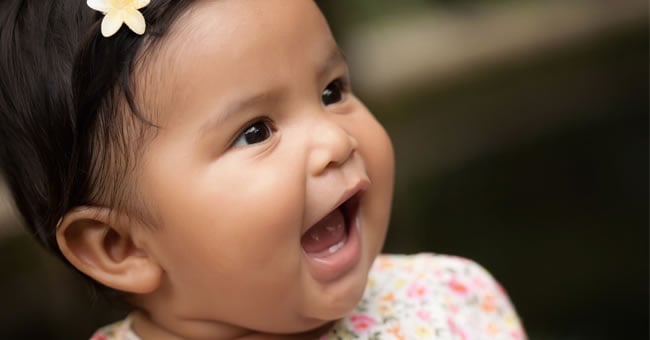
Understanding how the brain develops in children birth through age five and learning how you can support brain development is essential in helping the children in your care learn and grow. A proper knowledge of early brain development can guide your selection of activities for children to engage in and help you understand why the timing of certain simple interactions is so important. In Boosting Brain Power: 52 Ways to Use What Science Tells Us, Jill Stamm, PhD, provides a primer on brain development for educators and caregivers. She explains that brain development occurs in four simultaneous, dynamic ways: back to front, inside to outside, bottom to top, and right to left:
Back to Front
The first parts of the brain to develop are the ones that process vision. Babies cannot see clearly upon birth, but by six months, they can see almost as well as some adults. Following vision, the hearing parts of the brain develop. Babies can hear in utero and are able to recognize speech patterns and tones at birth. Still, newborns are not able to hear distinct speech sounds. Their ability to distinguish small variations in sounds develops at a fast pace, and children remain receptive to learning the sounds of new languages for the first few years of life. It's important to have young children's hearing screened if a parent or caregiver suspects a hearing issue.
Next, the large areas of the brain (forward and up) that combine sensory experiences of movement with sights and sounds begin to develop. While these motor skills develop, avoid over-restraining children. Yes, safety is important, but allowing children to find their own balance helps them naturally build the strength necessary to further develop motor advancements. The regions behind the forehead are responsible for more complex thinking such as planning, abstract reasoning, and understanding the consequences of one's actions. The process of development in this region continues into young adulthood.
Inside Out
Central structures (part of the limbic system) of the brain will eventually connect to the outer part (cortex) to process and regulate emotions. The central structures of the brain develop before the outer part, which controls the processing and storage of incoming information for thinking and planning. These emotional processing centers are well established from infancy to the time the child is roughly five years old. Environments that are safe and relationships that are loving, stimulating, predictable, and responsive to a child's needs build better, healthier brains.
Bottom Up
The brain stem develops very early and is responsible for heartbeat, breathing, temperature, and other basic functions. The ability to control emotions, focus thoughts, and coordinate fine motor movements develops later in the cortex regions. It is important to set realistic expectations for children based on their age. For example, young children may struggle to sit and listen for 20 minutes or more. While their attention span is developing, it is important to limit screen time for babies and young toddlers.
Right to Left
The right hemisphere of the brain is more active than the left in early infancy. The left begins to wire up by the end of the baby's first year. This allows receptive and expressive language skills to develop. Once skills are mastered, they tend to migrate to the left hemisphere. Both hemispheres continue to communicate with each other throughout a person's lifetime. Functions that tend to remain associated with the right hemisphere include recognizing faces, reading emotions, processing language syntax and intonation, and demonstrating some music competencies.
Be sure to browse the Insights and Inspirations section of our website for a variety of tips, strategies, and resources you can use to support children's brain development and education.
